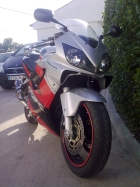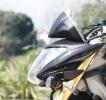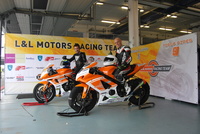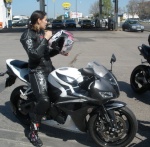|
| |
| Autor | Mensagem |
|---|
koffeebiker
CBR 500R

Número de Mensagens : 858
Idade : 43
Localização : Pégoes
Mota/Modelo : CBR 600 F 2003
Data de inscrição : 15/05/2009
 |  Assunto: Re: Honda CBR 600 F 2011 Assunto: Re: Honda CBR 600 F 2011  novembro 15th 2010, 13:21 novembro 15th 2010, 13:21 | |
| bem bem era irmos todos ver esses arranques e quem perdesse pagava almoçarada aos presentes...lol |
|   | | Doc_Daniel
CBR 600F3

Número de Mensagens : 2078
Idade : 42
Localização : Lisboa / Bombarral
Mota/Modelo : Hornet 600 F8
Data de inscrição : 12/04/2009
 | |   | | NunoTeixeira
CBR 600F4

Número de Mensagens : 2929
Idade : 40
Localização : Cascais
Mota/Modelo : CBR 600 rr 07
Data de inscrição : 27/10/2008
 | |   | | F1CT1C10U5
Administrador

Pendura : A Maria!
Número de Mensagens : 16301
Idade : 45
Localização : Casal da Silveira - Lisboa
Mota/Modelo : 2008 Honda CBR 1000RR '¹³'
Data de inscrição : 12/05/2009
 |  Assunto: Re: Honda CBR 600 F 2011 Assunto: Re: Honda CBR 600 F 2011  novembro 15th 2010, 16:45 novembro 15th 2010, 16:45 | |
| Eu já disse que ía filmar, para haver provas... É só marcarem  |
|   | | jam
CBR 900RR

Pendura : Anda na moto dela
Número de Mensagens : 12297
Idade : 65
Localização : porto
Mota/Modelo : 2012 CBR 1000 RA
Data de inscrição : 16/02/2009
 |  Assunto: Re: Honda CBR 600 F 2011 Assunto: Re: Honda CBR 600 F 2011  novembro 15th 2010, 18:49 novembro 15th 2010, 18:49 | |
| - F1CT1C10U5 escreveu:
- Eu já disse que ía filmar, para haver provas... É só marcarem
 Provas? De quê? Vinhos? Queijos? Hummm, também vou às provas. |
|   | | Edgar_Oliveira
CBR 1000RR

Pendura : Susana_Pires
Número de Mensagens : 28359
Idade : 35
Localização : Palmela
Mota/Modelo : CBR 1000RR 2009, EX CBR 600 F 2001, EX PCX 125 2010
Data de inscrição : 17/09/2009
 |  Assunto: Re: Honda CBR 600 F 2011 Assunto: Re: Honda CBR 600 F 2011  novembro 16th 2010, 01:21 novembro 16th 2010, 01:21 | |
| - Toniskas escreveu:
- Não vendas Ed, pinta só as jantes doutra cor... fica logo a andar mais... loool
é uma das alterações previstas para o ano, pois tenho de mandar desempenar a jante de traz ...voltar a cor de origem e fitas amarelas ou douradas. abraço |
|   | | marf
CBR 400RR

Número de Mensagens : 726
Idade : 47
Localização : Viana do Castelo
Mota/Modelo : BMW R1200GS
Data de inscrição : 05/04/2009
 |  Assunto: Re: Honda CBR 600 F 2011 Assunto: Re: Honda CBR 600 F 2011  novembro 17th 2010, 21:13 novembro 17th 2010, 21:13 | |
| Vou meter uma colherada só pra esclarecer as cavalagens  A potencia em CV (cavalos ou horsepower) é ligeiramente diferente da potência medida em BHP (brake horsepower). A potencia em BHP deduz as perdas devidas a componentes auxiliares do motor como a caixa de velocidades, bomba de água, alternador etc Por exemplo as Hornets tem 100 BHP equivalente a 103 CV  PS: Outra coisa que influencia a potência é a cor da mota ... as amarelas tem menos 10 cavalos enquanto as pretas são as que andam mais PS: Outra coisa que influencia a potência é a cor da mota ... as amarelas tem menos 10 cavalos enquanto as pretas são as que andam mais |
|   | | Edgar_Oliveira
CBR 1000RR

Pendura : Susana_Pires
Número de Mensagens : 28359
Idade : 35
Localização : Palmela
Mota/Modelo : CBR 1000RR 2009, EX CBR 600 F 2001, EX PCX 125 2010
Data de inscrição : 17/09/2009
 | |   | | shot
CBR 250R

Número de Mensagens : 289
Idade : 31
Localização : ali ao lado
Data de inscrição : 18/05/2010
 |  Assunto: Re: Honda CBR 600 F 2011 Assunto: Re: Honda CBR 600 F 2011  novembro 17th 2010, 22:06 novembro 17th 2010, 22:06 | |
| - marf escreveu:
- A potencia em BHP deduz as perdas devidas a componentes auxiliares do motor como a caixa de velocidades, bomba de água, alternador etc
Por exemplo as Hornets tem 100 BHP equivalente a 103 CV mas o bhp nao conta toda a perda até á roda certo? é impossivel uma mota ter uma perda de 3cv apenas  |
|   | | Caesar
CBR 150

Número de Mensagens : 181
Idade : 33
Localização : Leiria
Mota/Modelo : Honda RC212V scale 1:18
Data de inscrição : 06/02/2009
 |  Assunto: Re: Honda CBR 600 F 2011 Assunto: Re: Honda CBR 600 F 2011  novembro 20th 2010, 01:02 novembro 20th 2010, 01:02 | |
| BrakeHP são perdas teóricas...
As perdas ate a roda reais são enormes!
E sim também existe britishHP... |
|   | | galvas
CBR 600F

Número de Mensagens : 1259
Idade : 43
Localização : Fafe
Mota/Modelo : CBR 1000rr
Data de inscrição : 01/10/2008
 |  Assunto: Re: Honda CBR 600 F 2011 Assunto: Re: Honda CBR 600 F 2011  novembro 20th 2010, 15:27 novembro 20th 2010, 15:27 | |
| - Caesar escreveu:
- BrakeHP são perdas teóricas...
As perdas ate a roda reais são enormes!
E sim também existe britishHP... tou a ver que tens ido as aulinhas.. mt bem... hehehe |
|   | | jam
CBR 900RR

Pendura : Anda na moto dela
Número de Mensagens : 12297
Idade : 65
Localização : porto
Mota/Modelo : 2012 CBR 1000 RA
Data de inscrição : 16/02/2009
 |  Assunto: Re: Honda CBR 600 F 2011 Assunto: Re: Honda CBR 600 F 2011  novembro 21st 2010, 12:48 novembro 21st 2010, 12:48 | |
| Wikipedia:
Horsepower (HP) is the name of several units of measurement of power. The most common definitions equal between 735.5 and 750 watts.[1]
Horsepower was originally defined to compare the output of steam engines with the power of draft horses. The unit was widely adopted to measure the output of piston engines, turbines, electric motors, and other machinery. The definition of the unit varied between geographical regions. Most countries now use the SI unit watt for measurement of power. With the implementation of the EU Directive 80/181/EEC on January 1, 2010, the use of horsepower in the EU is only permitted as supplementary unit.
The definition of the horsepower also has varied between different applications:
The mechanical horsepower also known as imperial horsepower of exactly 550 foot-pounds per second is approximately equivalent to 745.7 watts.
The metric horsepower of 75 kgf-m per second is approximately equivalent to 735.499 watts.
The boiler horsepower is used for rating steam boilers and is equivalent to 34.5 pounds (≈15.65 kilograms) of water evaporated per hour at 212 degrees Fahrenheit (=100 degrees Celsius, =373.15 Kelvin), or 9,809.5 watts.
One imperial horsepower for rating electric motors is equal to 746 watts.
Continental European electric motors used to have dual ratings, using conversion rate 0.735 kW for 1 HP
The Pferdestärke PS (German translation of horsepower) is a name for a group of similar power measurements used in Germany around the end of the 19th century, all of about one metric horsepower in size.[2][3]
The Royal Automobile Club (RAC) horsepower or British tax horsepower is an estimate based on several engine dimensions.
History of the unit
The development of the steam engine provided a reason to compare the output of horses with that of the engines that could replace them. In 1702, Thomas Savery wrote in The Miner's Friend: "So that an engine which will raise as much water as two horses, working together at one time in such a work, can do, and for which there must be constantly kept ten or twelve horses for doing the same. Then I say, such an engine may be made large enough to do the work required in employing eight, ten, fifteen, or twenty horses to be constantly maintained and kept for doing such a work…" The idea was later used by James Watt to help market his improved steam engine. He had previously agreed to take royalties of one third of the savings in coal from the older Newcomen steam engines.[4] This royalty scheme did not work with customers who did not have existing steam engines but used horses instead. Watt determined that a horse could turn a mill wheel 144 times in an hour (or 2.4 times a minute). The wheel was 12 feet in radius; therefore, the horse travelled 2.4 × 2π × 12 feet in one minute. Watt judged that the horse could pull with a force of 180 pounds. So:
This was rounded to an even 33,000 ft·lbf/min.[5]
Others[who?] recount that Watt determined that a pony could lift an average 220 lbf (0.98 kN) 100 ft (30 m) per minute over a four-hour working shift. Watt then judged a horse was 50% more powerful than a pony and thus arrived at the 33,000 ft·lbf/min figure.[citation needed]
Engineering in History recounts that John Smeaton initially estimated that a horse could produce 22,916 foot-pounds per minute. John Desaguliers increased that to 27,500 foot-pounds per minute. "Watt found by experiment in 1782 that a 'brewery horse' was able to produce 32,400 foot-pounds per minute." James Watt and Matthew Boulton standardized that figure at 33,000 the next year.[6]
Most observers familiar with horses and their capabilities estimate that Watt was either a bit optimistic or intended to underpromise and overdeliver; few horses can maintain that effort for long. Regardless, comparison with a horse proved to be an enduring marketing tool.[citation needed]
A healthy human can produce about 1.2 hp briefly (see orders of magnitude) and sustain about 0.1 hp indefinitely; trained athletes can manage up to about 2.5 hp briefly[7] and 0.3 hp for a period of several hours.
[edit]Horsepower from a horse
In 1993, R. D. Stevenson and R. J. Wassersug published an article calculating the upper limit to an animal's power output.[8] The peak power over a few seconds has been measured to be as high as 14.9 hp. However, Stevenson and Wassersug observe that for sustained activity, a work rate of about 1 hp per horse is consistent with agricultural advice from both 19th and 20th century sources.
[edit]Current definitions
The following definitions have been widely used:
Mechanical horsepower
hp(I) ≡ 33,000 ft-lbf/min
= 550 ft·lbf/s
= 745.699872 W
Metric horsepower
hp(M) ≡ 75 kgf·m/s
≡ 735.49875 W
Electrical horsepower
hp(E) ≡ 746 W
Boiler horsepower
hp(S) ≡ 33,475 BTU/h
= 9,809.5 W
Hydraulic horsepower = flow rate (US gal/min) × pressure (psi) × 7/12,000
or
= flow rate (US gal/min) × pressure (psi) / 1714
= 550 ft·lbf/s
= 745.699872 W
In certain situations it is necessary to distinguish between the various definitions of horsepower and thus a suffix is added: hp(I) for mechanical (or imperial) horsepower, hp(M) for metric horsepower, hp(S) for boiler (or steam) horsepower and hp(E) for electrical horsepower.
Hydraulic horsepower is equivalent to mechanical horsepower. The formula given above is for conversion to mechanical horsepower from the factors acting on a hydraulic system.
[edit]Mechanical horsepower
Assuming the third CGPM (1901, CR 70) definition of standard gravity, gn=9.80665 m/s2, is used to define the pound-force as well as the kilogram force, and the international avoirdupois pound (1959), one mechanical horsepower is:
1 HP ≡ 33,000 ft·lbf/min by definition
= 550 ft·lbf/s since 1 min = 60 s
= 550×0.3048×0.45359237 m·kgf/s since 1 ft = 0.3048 m and
= 76.0402249068 kgf·m/s 1 lb = 0.45359237 kg
= 76.0402249068×9.80665 kg·m2/s3 g = 9.80665 m/s2
= 745.69987158227022 W since 1 W ≡ 1 J/s = 1 N·m/s = 1 (kg·m/s2)·(m/s)
Or given that 1 hp = 550 ft·lbf/s, 1 ft = 0.3048 m, 1 lbf ≈ 4.448 N, 1 J = 1 N·m, 1 W = 1 J/s: 1 hp = 746 W
[edit]Metric horsepower
Metric horsepower began in Germany in the 19th century and became popular across Europe and Asia. The various units used to indicate this definition (PS, CV, hk, pk, ks and ch) all translate to horse power in English, so it is common to see these values referred to as horsepower or hp in the press releases or media coverage of the German, French, Italian, and Japanese automobile companies. British manufacturers often intermix metric horsepower and mechanical horsepower depending on the origin of the engine in question. Sometimes the metric horsepower rating of an engine is conservative enough so that the same figure can be used for both 80/1269/EEC with metric hp and SAE J1349 with imperial hp.
Metric horsepower, as a rule, is defined as 0.73549875 kW, or roughly 98.6% of mechanical horsepower. This was a minor issue in the days when measurement systems varied widely and engines produced less power, but has become a major sticking point today. Exotic cars from Europe like the McLaren F1 and Bugatti Veyron are often quoted using the wrong definition, and their power output is sometimes even converted twice because of confusion over whether the original horsepower number was metric or mechanical.[citation needed]
[edit]PS
This unit (German: Pferdestärke = horse strength) is no longer a statutory unit, but is still commonly used in Europe, South America, Japan and India especially by the automotive and motorcycle industry. It was adopted throughout continental Europe with designations equivalent to the English horsepower, but mathematically different from the British unit.
DIN 66036 defines one horsepower to lift a mass of 75 kilograms within one second against the earth gravitation between a distance of one meter [9]. Similar definitions were already common to the time of James Watt.
Thus result in
Unit definitions:
The PS was adopted by the Deutsches Institut für Normung (DIN) and then by the automotive industry throughout most of Europe, under varying names. In 1992, the PS was rendered obsolete by EEC directives, when it was replaced by the kilowatt as the official power measuring unit. It is still in use for commercial and advertising purposes, in addition to the kW rating, as many customers are still not familiar with the use of kilowatts for engines.
[edit]pk, hk, hv, LE, k/ks, KS, KM, CP, PS
The Dutch paardenkracht (pk), the Swedish hästkraft (hk), the Finnish hevosvoima (hv), the Norwegian and Danish hestekraft (hk), the Hungarian lóerő (LE), the Czech koňská síla and Slovak koňská sila (k or ks), the Croatian and Serbian konjska snaga (KS), the Macedonian Којнска сила (KC), the Polish koń mechaniczny and Slovenian konjska moč (KM), the Romanian cal-putere (CP), and the Japanese PS (JIS) all equal the German Pferdestärke (PS).
[edit]CV and cv
In Italian (Cavalli), Spanish (Caballos de vapor), and Portuguese (Cavalo-vapor), CV is the equivalent to the German, PS. It is also used as the French term for the Pferdestärke, but in French, this should be written in lowercase letters as cv.
In addition, the capital form CV is used in Italy and France as a unit for tax horsepower, short for, respectively, cavalli vapore and chevaux vapeur (steam horses). CV is a non-linear rating of a motor vehicle for tax purposes.[10] The CV rating, or fiscal power, is , where P is the maximum power in kilowatts and U is the amount of CO2 emitted in grams per kilometre. The term for CO2 measurements has only been included in the definition since 1998, so older ratings in CV are not directly comparable. The fiscal power has found its way into naming of automobile models, such as the popular Citroën deux-chevaux. The cheval-vapeur (ch) unit should not be confused with the French cheval fiscal (CV).
In the 19th century, the French had their own unit, which they used instead of the CV or horsepower. It was called the poncelet and was abbreviated p.
[edit]ch
This is a French unit for automobile power. The symbol ch is short for chevaux (horses). It has the same definition as the German PS, and is approximatively equal to 735.5 W.
[edit]Boiler horsepower
A boiler horsepower is used for boilers in various industrial applications, however it is considered an antiquated term and is not used in modern power plants except in North America, where it persists in industrial boiler engineering. One Boiler Horse Power Unit or BHP is equal to a boiler thermal output of 33,475 BTU/h (9.8095 kW), which is the energy rate needed to evaporate 34.5 lb (15.65 kg) of water at 212 °F (100 °C) in one hour.
The term was originally developed at the Philadelphia Centennial Exhibition in 1876, where the best steam engines of that period were tested. The average steam consumption of those engines (per output horsepower) was determined to be the evaporation of 30 lb/h of water, based on feedwater at 100 °F (38 °C), and saturated steam generated at 70 psi (480 kPa) gauge pressure. This original definition is equivalent to a boiler heat output of 33,485 BTU/h. In 1884, the ASME re-defined the boiler horsepower as the thermal output equal to the evaporation of 34.5 lb/h of water "from and at" 212 °F. This considerably simplified boiler testing, and provided more accurate comparisons of the boilers at that time. This revised definition is equivalent to a boiler heat output of 33,469 BTU/hr. Present industrial practice is to define boiler horsepower as a boiler thermal output equal to 33,475 BTU/h, which is very close to the original and revised definitions.
The amount of power that can be obtained by a steam engine or steam turbine based on boiler horsepower varies so widely that use of the term is entirely obsolete for these purposes. The term makes no distinction as to the steam pressure or temperature which is produced (both of which significantly influence engine/turbine output), it merely defines a thermal output of a boiler. Smaller steam engines often require several boiler horsepower to make one horsepower, and modern steam turbines can make power with as little as about 0.15 hp (boiler) thermal output per actual horsepower developed.
[edit]Electrical horsepower
The horsepower used for electrical machines is defined as exactly 746 W. The nameplates on electrical motors show their power output, not their power input
[edit]Relationship with torque
For a given torque and speed, the power may be calculated; the relationship between torque in foot-pounds, rotational speed in RPM and horsepower is:
Where P is power, Τ is torque, and ω is rotations per minute. The constant 5252 comes from (33,000 ft·lbf/min)/(2π rad./rev.).
The standard equation relating torque in in-lbf, rotational speed in RPM and horsepower is:
Where P is power, Τ is torque, and ω is rotations per minute. The constant 63,025 comes from (33,000 ft·lbf/min)x(12 in/ft)/(2π rad./rev.).
See torque.
[edit]Drawbar horsepower
See also Power at rail
Drawbar horsepower (dbhp) is the power a railway locomotive has available to haul a train or an agricultural tractor to pull an implement. This is a measured figure rather than a calculated one. A special railway car called a dynamometer car coupled behind the locomotive keeps a continuous record of the drawbar pull exerted, and the speed. From these, the power generated can be calculated. To determine the maximum power available, a controllable load is required; it is normally a second locomotive with its brakes applied, in addition to a static load.
If the drawbar force () is measured in pound-force (lbf) and speed () is measured in miles per hour (mph), then the drawbar power () in horsepower (hp) is:
Example: How much power is needed to pull a drawbar load of 2,025 pounds-force at 5 miles per hour?
The constant 375 is because 1 hp = 375 lbf·mph. If other units are used, the constant is different. When using a coherent system of units, such as SI (watts, newtons, and metres per second), no constant is needed, and the formula becomes .
[edit]RAC horsepower (taxable horsepower)
See also: Tax horsepower
This measure was instituted by the Royal Automobile Club in Britain and was used to denote the power of early 20th century British cars. Many cars took their names from this figure (hence the Austin Seven and Riley Nine), while others had names such as "40/50 hp", which indicated the RAC figure followed by the true measured power.
Taxable horsepower does not reflect developed horsepower; rather, it is a calculated figure based on the engine's bore size, number of cylinders, and a (now archaic) presumption of engine efficiency. As new engines were designed with ever-increasing efficiency, it was no longer a useful measure, but was kept in use by UK regulations which used the rating for tax purposes.
where
D is the diameter (or bore) of the cylinder in inches
n is the number of cylinders [11]
This is equal to the displacement in cubic inches divided by 10π then divided again by the stroke in inches.
Since taxable horsepower was computed based on bore and number of cylinders, not based on actual displacement, it gave rise to engines with 'undersquare' dimensions (i.e., relatively narrow bore), but long stroke; this tended to impose an artificially low limit on rotational speed (rpm), hampering the potential power output and efficiency of the engine.
The situation persisted for several generations of four- and six-cylinder British engines: for example, Jaguar's 3.4-litre XK engine of the 1950s had six cylinders with a bore of 83 mm (3.27 in) and a stroke of 106 mm (4.17 in),[12] where most American automakers had long since moved to oversquare (wide bore, short stroke) V-8s (see, for example, the early Chrysler Hemi).
[edit]Measurement
The power of an engine may be measured or estimated at several points in the transmission of the power from its generation to its application. A number of names are used for the power developed at various stages in this process, but none is a clear indicator of either the measurement system or definition used.
In the case of an engine dynamometer, power is measured at the engine's flywheel (i.e., at the crankshaft output). With a chassis dynamometer or rolling road, power output is measured at the driving wheels. This accounts for the significant power loss through the drive train.
In general:
Nominal is derived from the size of the engine and the piston speed and is only accurate at a pressure of 48 kPa (7 psi).[13]
Indicated or gross horsepower (theoretical capability of the engine) [ PLAN/ 33000]
minus frictional losses within the engine (bearing drag, rod and crankshaft windage losses, oil film drag, etc.), equals
Brake / net / crankshaft horsepower (power delivered directly to and measured at the engine's crankshaft)
minus frictional losses in the transmission (bearings, gears, oil drag, windage, etc.), equals
Shaft horsepower (power delivered to and measured at the output shaft of the transmission, when present in the system)
minus frictional losses in the universal joint/s, differential, wheel bearings, tire and chain, (if present), equals
Effective, True (thp) or commonly referred to as wheel horsepower (whp)
All the above assumes that no power inflation factors have been applied to any of the readings.
Engine designers use expressions other than horsepower to denote objective targets or performance, such as brake mean effective pressure (BMEP). This is a coefficient of theoretical brake horsepower and cylinder pressures during combustion.
[edit]Nominal horsepower
Nominal horsepower (nhp) is an early Nineteenth Century rule of thumb used to estimate the power of steam engines.
nhp = 7 x area of piston x equivalent piston speed/33,000
For paddle ships the piston speed was estimated as 129.7 x (stroke)1/3.35
For the nominal horsepower to equal the actual power it would be necessary for the mean steam pressure in the cylinder during the stroke to be 48 kPa (7 psi) and for the piston speed to be of the order of 54–75 m/min.[13]
[edit]Indicated horsepower
Indicated horsepower (ihp) is the theoretical power of a reciprocating engine if it is completely frictionless in converting the expanding gas energy (piston pressure × displacement) in the cylinders. It is calculated from the pressures developed in the cylinders, measured by a device called an engine indicator – hence indicated horsepower. As the piston advances throughout its stroke, the pressure against the piston generally decreases, and the indicator device usually generates a graph of pressure vs stroke within the working cylinder. From this graph the amount of work performed during the piston stroke may be calculated. It was the figure normally used for steam engines in the 19th century but is misleading because the actual power output may only be 70% to 90% of the indicated horsepower.
[edit]Brake horsepower
Brake horsepower (bhp) is the measure of an engine's horsepower before the loss in power caused by the gearbox, alternator, differential, water pump, and other auxiliary components such as power steering pump, muffled exhaust system, etc. Brake refers to a device which was used to load an engine and hold it at a desired RPM. During testing, the output torque and rotational speed were measured to determine the brake horsepower. Horsepower was originally measured and calculated by use of the indicator (a James Watt invention of the late 18th century), and later by means of a De Prony brake connected to the engine's output shaft. More recently, an engine dynamometer is used instead of a De Prony brake. The output delivered to the driving wheels is less than that obtainable at the engine's crankshaft.
[edit]British horsepower
The abbreviation bhp may also be used for British horsepower, which has the same definition as the American SAE gross brake horsepower: 33,000 lb·ft/min. More information on American SAE horsepower measurements is below.
[edit]Shaft horsepower
Shaft horsepower (shp) is the power delivered to the propeller shafts of a steamship (or one powered by diesel engines or nuclear power), or an aircraft powered by a piston engine or a gas turbine engine. This shaft horsepower can be measured with instruments, or estimated from the indicated horsepower and a standard figure for the losses in the transmission (typical figures are around 10%). This measure is uncommonly used in the automobile industry, because there, drive train losses can be significant.
[edit]Engine power test codes
Engine power test codes determine how the power and torque of an automobile engine is measured and corrected. Correction factors are used to adjust power and torque measurements to standard atmospheric conditions to provide a more accurate comparison between engines as they are affected by the pressure, humidity, and temperature of ambient air[14]. There exist several standards for this purpose, some described below.
[edit]Society of Automotive Engineers
[edit]SAE gross power
Prior to the 1972 model year, American automakers rated and advertised their engines in brake horsepower (bhp), frequently referred to as SAE gross horsepower, because it was measured in accord with the protocols defined in SAE standards J245 and J1995. As with other brake horsepower test protocols, SAE gross hp was measured using a stock test engine, generally running with few belt-driven accessories and sometimes fitted with long tube (test headers) in lieu of the OEM exhaust manifolds. The atmospheric correction standards for barometric pressure, humidity and temperature for testing were relatively idealistic.
[edit]SAE net power
In the United States, the term bhp fell into disuse in 1971-72, as automakers began to quote power in terms of SAE net horsepower in accord with SAE standard J1349. Like SAE gross and other brake horsepower protocols, SAE Net hp is measured at the engine's crankshaft, and so does not account for transmission losses. However, the SAE net power testing protocol calls for standard production-type belt-driven accessories, air cleaner, emission controls, exhaust system, and other power-consuming accessories. This produces ratings in closer alignment with the power produced by the engine as it is actually configured and sold.
[edit]SAE certified power
In 2005, the SAE introduced "SAE Certified Power" with SAE J2723[15]. This test is voluntary and is in itself not a separate engine test code but a certification of either J1349 or J1995 after which the manufacturer is allowed to advertise "Certified to SAE J1349" or "Certified to SAE J1995" depending on which test standard have been followed. To attain certification the test must follow the SAE standard in question, take place in a ISO9000/9002 certified facility and be witnessed by an SAE approved third party.
A few manufacturers such as Honda and Toyota switched to the new ratings immediately, with multi-directional results; the rated output of Cadillac's supercharged Northstar V8 jumped from 440 to 469 hp (330 to 350 kW) under the new tests, while the rating for Toyota's Camry 3.0 L 1MZ-FE V6 fell from 210 to 190 hp (160 to 140 kW). The ES330 and Camry SE V6 were previously rated at 225 hp but the ES330 dropped to 218 hp (163 kW) while the Camry declined to 210 hp (160 kW). The first engine certified under the new program was the 7.0 L LS7 used in the 2006 Chevrolet Corvette Z06. Certified power rose slightly from 500 to 505 hp (370 to 377 kW).
While Toyota and Honda are retesting their entire vehicle lineups, other automakers generally are retesting only those with updated powertrains. For example, the 2006 Ford Five Hundred is rated at 203 horsepower, the same as that of 2005 model. However, the 2006 rating does not reflect the new SAE testing procedure as Ford is not going to spend the extra expense of retesting its existing engines. Over time, most automakers are expected to comply with the new guidelines.
SAE tightened its horsepower rules after some engineers noticed parts of the old test could be subjected to different interpretations. Under the old testing procedures, there were small factors that required a judgment call: how much oil was in the crankcase, how the engine controls were calibrated and whether a vehicle was tested with premium fuel. In some cases, such can add up to a change in horsepower ratings. A road test editor at Edmunds.com, John Di Pietro, said decreases in horsepower ratings for some '06 models are not that dramatic. For vehicles like a midsize family sedan, it is likely that the reputation of the manufacturer will be more important.[16]
[edit]Deutsches Institut für Normung 70020
DIN 70020 is a standard from German DIN regarding road vehicles. Because the German word for horsepower is Pferdestärke, in Germany it is commonly abbreviated to PS. DIN hp is measured at the engine's output shaft, and is usually expressed in metric (Pferdestärke) rather than mechanical horsepower.
[edit]Economic Commission for Europe R24
ECE R24 is a European standard for the approval of compression ignition engine emissions, installation and measurement of engine power[17]. It is similar to DIN 70020 standard, but with different requirements for connecting an engine's fan during testing causing it to absorb less power from the engine[18].
[edit]80/1269/EEC
80/1269/EEC of 16 December 1980 is a European Union standard for road vehicle engine power.
[edit]International Organization for Standardization
ISO 14396 specifies the additional and method requirement for determinating the power of reciprocating internal combustion engines when presented for an ISO 8178 exhaust emission test. It applies to reciprocating internal combustion engines for land, rail and marine use excluding engines of motor vehicles primarily designed for road use [19].
ISO 1585 is an engine net power test code intended for road vehicles[20].
ISO 2534 is an engine gross power test code intended for road vehicles[21]
ISO 4164 is an engine net power test code intended for mopeds[22].
ISO 4106 is an engine net power test code intended for motorcycles[23].
ISO 9249 is an engine net power test code intended for earth moving machines[24].
[edit]Japanese Industrial Standard D 1001
JIS D 1001 is a Japanese net, and gross, engine power test code for automobiles or trucks having a spark ignition, diesel engine, or fuel injection engine.[25] |
|   | | killer
CBR 600F3

Pendura : paula r.
Número de Mensagens : 2032
Idade : 42
Localização : olhao
Mota/Modelo : HONDA VFR 800 V-TEC `02
Data de inscrição : 07/07/2009
 |  Assunto: Re: Honda CBR 600 F 2011 Assunto: Re: Honda CBR 600 F 2011  novembro 21st 2010, 19:38 novembro 21st 2010, 19:38 | |
| jam,podes repetir...........................................em portuges?  |
|   | | dino
CBR 250R

Número de Mensagens : 292
Idade : 43
Localização : anadia
Data de inscrição : 19/09/2010
 |  Assunto: Re: Honda CBR 600 F 2011 Assunto: Re: Honda CBR 600 F 2011  novembro 21st 2010, 20:04 novembro 21st 2010, 20:04 | |
| Jammmmmmm,ke testamentooooooo,e ainda por cima em estrangeirooooooo  |
|   | | jam
CBR 900RR

Pendura : Anda na moto dela
Número de Mensagens : 12297
Idade : 65
Localização : porto
Mota/Modelo : 2012 CBR 1000 RA
Data de inscrição : 16/02/2009
 |  Assunto: Re: Honda CBR 600 F 2011 Assunto: Re: Honda CBR 600 F 2011  novembro 22nd 2010, 08:40 novembro 22nd 2010, 08:40 | |
| Posso, mas hoje não. Tenho que ter tempo.
Só fui tirar o que está na wikipedia. |
|   | | Edgar_Oliveira
CBR 1000RR

Pendura : Susana_Pires
Número de Mensagens : 28359
Idade : 35
Localização : Palmela
Mota/Modelo : CBR 1000RR 2009, EX CBR 600 F 2001, EX PCX 125 2010
Data de inscrição : 17/09/2009
 | |   | | Edgar_Oliveira
CBR 1000RR

Pendura : Susana_Pires
Número de Mensagens : 28359
Idade : 35
Localização : Palmela
Mota/Modelo : CBR 1000RR 2009, EX CBR 600 F 2001, EX PCX 125 2010
Data de inscrição : 17/09/2009
 |  Assunto: Re: Honda CBR 600 F 2011 Assunto: Re: Honda CBR 600 F 2011  dezembro 12th 2010, 15:20 dezembro 12th 2010, 15:20 | |
| so para voltar a salientar aquilo dissemos: http://motokando.com/index.php/motos-2011/101286-honda-cbr-600f-2011-uma-hornet-carenada agarraram na hornet e meteram-lhe umas carenagens  lá se vai a mítica 600F  |
|   | | CBR666
CBR 600F3

Número de Mensagens : 2360
Idade : 39
Localização : Lisboa
Mota/Modelo : CBR 600 RR e KTM SX-F 250
Data de inscrição : 17/10/2010
 |  Assunto: Re: Honda CBR 600 F 2011 Assunto: Re: Honda CBR 600 F 2011  dezembro 12th 2010, 16:11 dezembro 12th 2010, 16:11 | |
| Acho a mota muita bonita, mudando-lhe aquele escape de origem por um de Moto GP era a cereja no topo do bolo.
Li um reportagem na Moto Jornal aqui a semanas sobre a mota e parece-me que está bastante boa. |
|   | | denver
CBR 600F4i

Pendura : Marlene
Número de Mensagens : 3048
Idade : 40
Localização : Southampton-UK
Mota/Modelo : CBR300Ra,Ex CBR1100XX/Suzuki GSF 600 Bandit S /EX Triumph Legend 900 TT. Ex CBR125
Data de inscrição : 23/05/2010
 |  Assunto: Re: Honda CBR 600 F 2011 Assunto: Re: Honda CBR 600 F 2011  dezembro 12th 2010, 16:33 dezembro 12th 2010, 16:33 | |
| nao gosto da frente
axo que os modelos actuais sao muito fixe
|
|   | | Edgar_Oliveira
CBR 1000RR

Pendura : Susana_Pires
Número de Mensagens : 28359
Idade : 35
Localização : Palmela
Mota/Modelo : CBR 1000RR 2009, EX CBR 600 F 2001, EX PCX 125 2010
Data de inscrição : 17/09/2009
 |  Assunto: Re: Honda CBR 600 F 2011 Assunto: Re: Honda CBR 600 F 2011  dezembro 12th 2010, 16:43 dezembro 12th 2010, 16:43 | |
| ou seja o modelo da minha, é o ultimo ate sair para o ano esta. |
|   | | M.Afonso
CBR 600RR

Pendura : Tem k merecer esse privilegio
Número de Mensagens : 4235
Idade : 45
Localização : MALPARTIDA-ALMEIDA-GUARDA
Mota/Modelo : CBR 1000 RR 06
Data de inscrição : 29/12/2008
 |  Assunto: Re: Honda CBR 600 F 2011 Assunto: Re: Honda CBR 600 F 2011  dezembro 12th 2010, 16:50 dezembro 12th 2010, 16:50 | |
| - Planzinho escreveu:
- Outra F? Pensava que isso já era passado na Honda!
As 600 F foram as motas k mais venda tiveram na Honda!!!! E Kem deu fama a Honda foi a CBR 600 F... isto como e obvio não e estar a desfazer das outras HONDA's, claro!! E eu se pudesse, tb não era uma F k eu tinha, claro k era uma 1000 RR 2007!!!  |
|   | | Edgar_Oliveira
CBR 1000RR

Pendura : Susana_Pires
Número de Mensagens : 28359
Idade : 35
Localização : Palmela
Mota/Modelo : CBR 1000RR 2009, EX CBR 600 F 2001, EX PCX 125 2010
Data de inscrição : 17/09/2009
 |  Assunto: Re: Honda CBR 600 F 2011 Assunto: Re: Honda CBR 600 F 2011  dezembro 16th 2010, 17:47 dezembro 16th 2010, 17:47 | |
| oh marcio mas tu n tens pq n queres, preferes ter uma 600F e uma moto 4, são opções, já no aniversário do forum fiz as contas e te mostrei que conseguias ir buscar a 1000rr 07 entregando as duas mais qql coisa, n muito  |
|   | | sombrio
CBR 600F2

Número de Mensagens : 1531
Idade : 44
Localização : Setubal
Data de inscrição : 24/10/2009
 | |   | | Zebrada
CBR 600F2

Número de Mensagens : 1609
Idade : 38
Localização : Seixal
Mota/Modelo : CBR600fSport 03/ CBR600RR 07 ZEBRA
Data de inscrição : 29/10/2008
 | |   | | Edgar_Oliveira
CBR 1000RR

Pendura : Susana_Pires
Número de Mensagens : 28359
Idade : 35
Localização : Palmela
Mota/Modelo : CBR 1000RR 2009, EX CBR 600 F 2001, EX PCX 125 2010
Data de inscrição : 17/09/2009
 |  Assunto: Re: Honda CBR 600 F 2011 Assunto: Re: Honda CBR 600 F 2011  fevereiro 9th 2011, 14:01 fevereiro 9th 2011, 14:01 | |
| se compararmos com o preço da hornet, base que serviu para tudo e pouco mudaram, nem ta cara, 1000€ de diferença. |
|   | | Conteúdo patrocinado
 | |   | | |
Tópicos semelhantes |  |
|
| | Permissões neste sub-fórum | Não podes responder a tópicos
| |
| |
| | Últimos assuntos | » Cbr 600f4 do ano 1999 novembro 17th 2024, 11:04 por F1CT1C10U5» Para quando? novembro 16th 2024, 19:52 por sasnag» "Morreram Todos" CBR 1100xx  novembro 13th 2024, 11:21 por F1CT1C10U5» Ottocast Lite C5 vale a pena ? outubro 31st 2024, 17:05 por parchao» Trackday 12 Maio Estoril  outubro 7th 2024, 20:43 por sasnag» Vamos rir!! Anedotas&companhia setembro 26th 2024, 12:45 por F1CT1C10U5» Indicador de mudança F3 agosto 29th 2024, 15:17 por PMina» Vibração  agosto 13th 2024, 23:07 por JoelAntunes» Tópico dos desabafos agosto 6th 2024, 09:16 por Paulo Laia-HULK» Temperatura Cbr 600RR 06 julho 18th 2024, 10:05 por pbmonteiro84» Lacar jantes! Onde? julho 17th 2024, 15:05 por Diogo Magalhães» Tensor de corrente CBR 1000f junho 8th 2024, 11:07 por Gphillip» Honda Cbr 954 Não liga Retificador ou Stator? junho 8th 2024, 11:03 por Gphillip» Pastilhas de travão  junho 4th 2024, 11:06 por pbmonteiro84» Onde comprar amortecedor de direção junho 3rd 2024, 16:10 por Paulo Laia-HULK» Estranha avaria junho 3rd 2024, 16:06 por Paulo Laia-HULK» Manual de Alterações de caraterísticas  maio 29th 2024, 22:55 por M.Afonso» CBR 1100 XX Temperatura maio 23rd 2024, 22:18 por leao» Honda CBR 1000F - estava a passar pelos 200km/h quando... maio 3rd 2024, 12:19 por luisr320@gmail.com» Descubra a beleza de Ponte da Barca: Um passeio encantador pelo coração do Minho abril 26th 2024, 07:20 por parchao» Cbr 600f4i 2007 abril 22nd 2024, 15:06 por Paulo Laia-HULK» MotoGP Portimão Março 2024 abril 17th 2024, 10:47 por Paulo Laia-HULK» manomtero fuel cbr 600 f2 abril 12th 2024, 17:57 por PSonic» Natureza SELVAGEM : QUEDAS de Água do Gerês Xurés abril 7th 2024, 14:09 por parchao» Motovloggers em Evolução: Desconstruindo Hábitos março 26th 2024, 15:52 por PSonic |
| novembro 2024 | | Seg | Ter | Qua | Qui | Sex | Sáb | Dom |
|---|
| | | | | 1 | 2 | 3 | | 4 | 5 | 6 | 7 | 8 | 9 | 10 | | 11 | 12 | 13 | 14 | 15 | 16 | 17 | | 18 | 19 | 20 | 21 | 22 | 23 | 24 | | 25 | 26 | 27 | 28 | 29 | 30 | |  Calendário Calendário |
|
| Quem está conectado? | Há 639 usuários online :: 0 registrados, 0 invisíveis e 639 visitantes :: 3 motores de busca
Nenhum
O recorde de usuários online foi de 2383 em novembro 22nd 2020, 14:41
|
|








